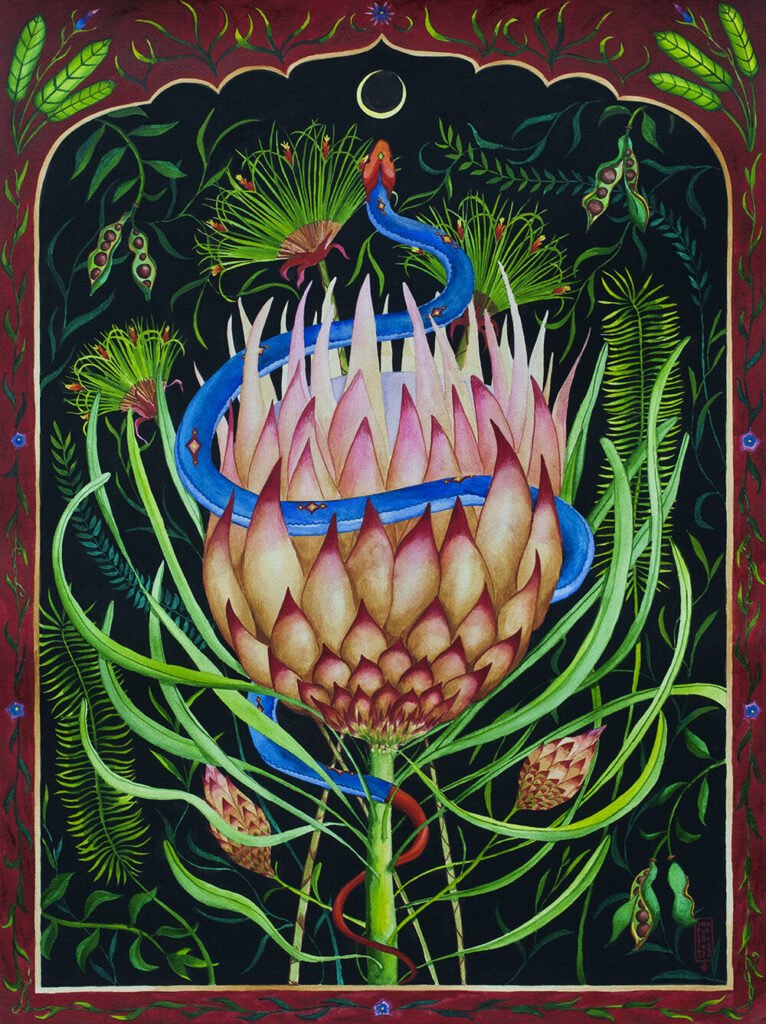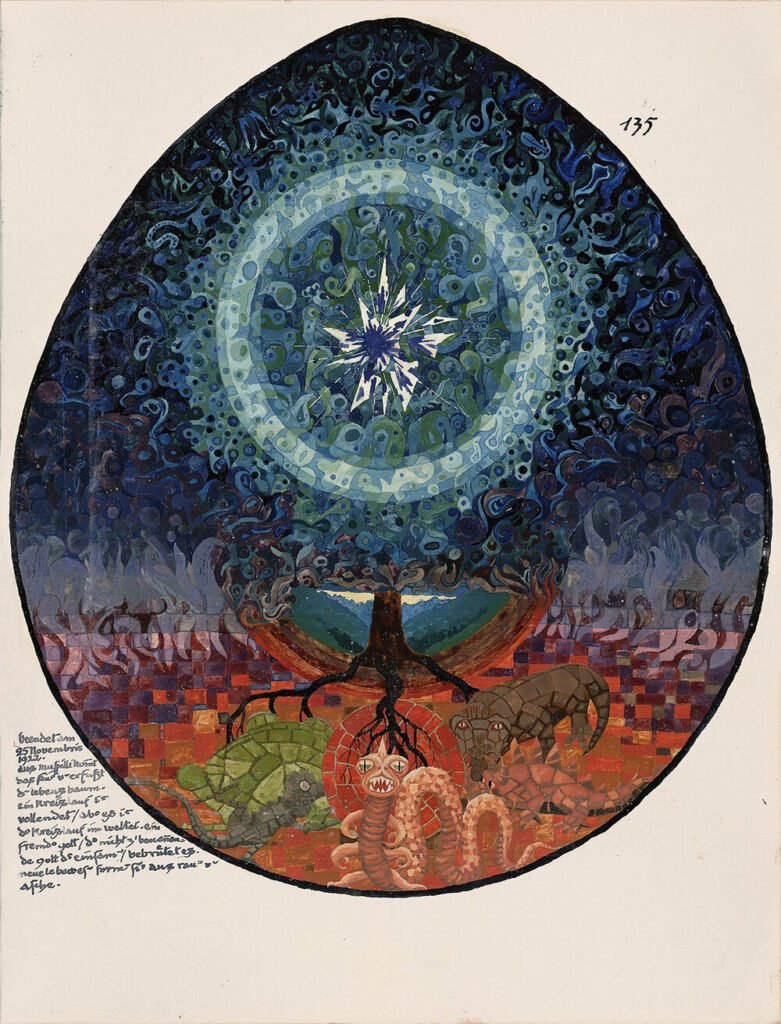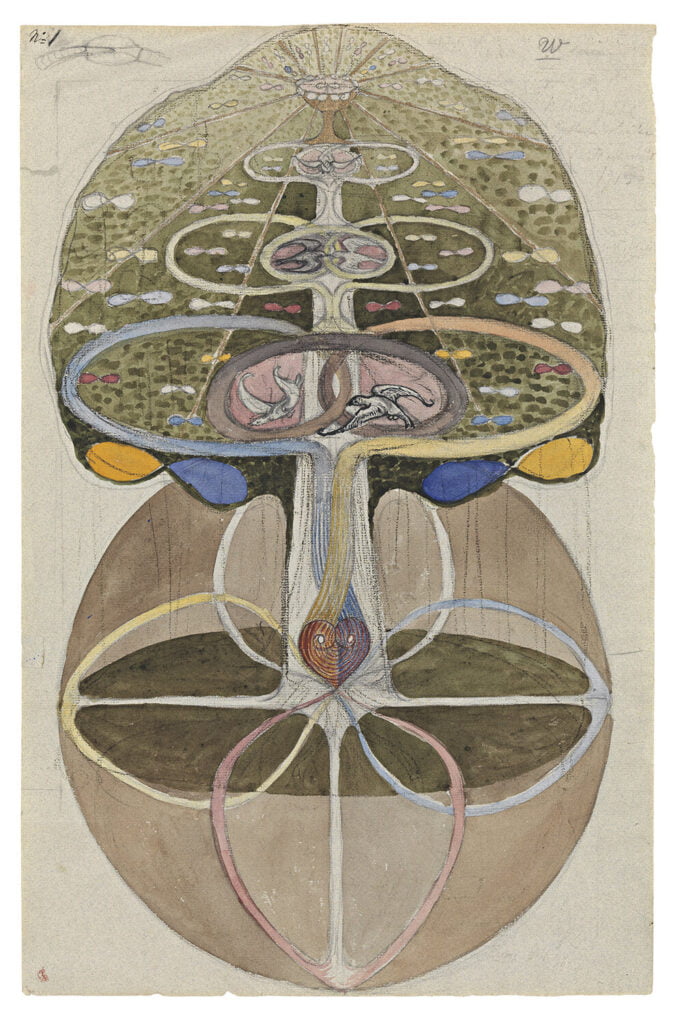
Delfina Muñoz de Toro, Vimi Yuve (Fruit of the Serpent), 2019. Watercolour on paper, 61 x 45.5 cm. Credit: courtesy the artist
One of the things that make ‘The Botanical mind’ a unique show in marvellous accordance with our momentum is that, as a structure, it keeps an organic quality very relevant with what it discusses. Actually, it was the pandemic situation that produced that need and brought out its organicity. In order to comply with the conditions and find an audience, the evolved in new ways, becoming a rhizomatic show, if not a meditation (web)site-non site (in a Smithson approach) or an open encyclopaedia about re-approaching nature with new means, indigenous spirituality and empathy.
At the same time, the pandemic and all the issues that it exposed regarding anthropocentrism, vulnerability and the failure of western civilisation, deduce the exhibition’s subject to an urgent field of research and discussions.
Beyond everything else, it could always be considered an exhibition about healing.
Using ethnographical, philosophical, scientific and cultural research, and approaching its subject not only through the galleries but also through the web, with online projects, numerous articles and podcasts along with an illuminating publication, ‘Botanical Mind’ opens up to its spectators, readers and visitors like a tree — borrowing the form of its opening topic, the tree of life — expanding its thematic branches to a broad horizon of contemplation.
Physically visiting the exhibition was a spectacular experience that I feel lucky to have had. However, I wish I had previously looked at the website in detail, as the exhaustive amount of information it offers, reveals and clarifies the show’s infrastructure.

C.G. Jung, The Tree of Life
David Tudor, the genius composer, student and collaborator of John Cage and Merce Cunningham, is the creator of the airy and bizarre sound composition ‘Rainforest I’, that welcomes, and prepares, the visitor before starting the long meditative trip into the galleries. The opening subject and central element of the curatorial research is the tree of knowledge that somehow predesignates the whole itinerary.
The Cosmic Tree, Axis Mundi or Tree of Immortality, a recurring motif among religions, mythologies and popular culture, symbolises the human condition’s connection to the transcendental universe. From Eden to Druids, from Jung to Tolkien, the image of the big wise tree has been a creative inspiration since Neo-Assyrian art. We can see its manifestations among others in Carl Jung’s mystic drawings, Delfina Munoz de Toro’s spectacular universes of colours and Linder’s surrealistic photographic collages.
Mandalas, the famous meditational circular designs that we meet in Hindu and Buddhist cultures as the universe’s representation, are another frequent motif, often used as an artistic expression of interconnectivity and spiritual awareness. Mandala images are prominent throughout the show, their effect being utterly seductive in Daniel Rios Rodriguez’s work, dizzying in Adolf Wölfli drawing meditations and mind-blowing in the pale energy fields of Gemma Anderson.
Like mandalas, several other symbols, primary forms and sacred geometrical patterns repeatedly emerge in nature and science, not only in natural morphologies but also in the visions induced by psychoactive plants.
The Yawanawá, the Shipibo-Conibo and the Huni Kuin people, among others Indigenous populations in the Amazon Rainforest, inheritors of rare wisdom concerning plants and animals of their precious ecosystems use natural geometrical shapes that they call ‘kené’ (sacred designs) as decorative motifs for their ceramics, textiles and even their skin.
Artists all over time have been adopting secret geometry in multiple ways: they can be found inside musical compositions and non-objective films; in Anni Albers’ embroidered ‘Ancient Writings’; in the multi-coloured playful abstractions of Yves Laloy; or the enigmatic heraldic shapes of the mystic experimental cinematographer Jordan Belson.
Vegetal imagery is another dominant theme, manifesting the symmetry, beauty and expressive visual power of the plant kingdom.
According to Rupert Sheldrake, beauty is a natural mechanism inherent in the environment, expressing an internal resonance between the human mind and the universe. As he points out: “Darwin proposed that there would have been no flowers until there were eyes to appreciate them – designed by nature to attract mobile creatures to pollinate for them”.
The flowery compositions of Joseph Kotzian, Anna Zemánková and Anna Haskel seem to explore this idea with their focus on complex seductive details, eye-catching symmetries and repetitions inside the structure of the flower. Meanwhile, Joachim Koester’s black and white fractal landscapes are revealed to be a microscopic scan of cocaine alkaloids and cannabis plants’ surface structure.

Hilma af Klint, Tree of Knowledge, No 1, The W Series, 1913. Watercolour, gouache, graphite and metallic paint on paper. Courtesy of the Hilma af Klint Foundation. Photo: Modern Museet, Stockholm
The shows consists of so man powerful artworks: Hilma af Klint’s idiosyncratic abstraction in her ‘Tree of life’ (1913); Bruce Conner’s spellbinding paintings and his inkblot Rorschach drawings; the occult erotism of Penny Slinger’s collages; Fred Tomasseli’s labyrinthian anatomy; and alchemical rituals of Kerstin Brätsch.
The show is occupied by the spirit of great minds, along with several ideas and theories. Especially C. C. Jung’s symbolism and research, and Hildegarde of Bingen’s natural cosmology and healing practice seem to run all over the exhibition’s chapters. The Pythagorean Music of the Spheres, ancient Greek mythology, shamanism and the mysterious and undeciphered Voynich Manuscript contribute considerably in the theoretical and visual structure.
Far from being just an exhibition, ‘Botanical mind’ comprises a whole area of multidisciplinary investigation around the extraordinary issue of plant intelligence. It manages to balance with remarkable grace and credibility entirely diverging fields like physical sciences, psychoanalysis, ecology, culture, and occult spirituality while providing enough stimulus for an in-depth reconsideration of our relationship with the natural world.
Take a look at ‘The Botanical Mind’ online here
Filed under: Art & Photography
Tagged with: botanical, Botanical Mind, Camden Arts Centre, cosmos, exhibition, geometry, inteligence, mythology, natural, Nature, Plant, plants, review, sacred, tree, universe, vegetal



Comments